Refine search
No keyword found to refine search
keywords EN
Places
Names
214 documents found
| 1 | 4 |
Documents per page :

Lalish
Gabriel Gauffre / Le Pictorium
LePictorium_0282186.jpg
View of the Lalish temples.
Lalish, located in the heart of Iraqi Kurdistan, is the most sacred site to the Yazidi. They must make the pilgrimage there at least once in their life, for six days, in order to pay their respects to Sheikh Adi ibn Musafir’s tomb, the founder of the religion. They are about 700 000 in Iraq. Founded in the 12th century, the religion mixes elements of Islam with local pre-Islamic beliefs, making them a major target during the expansion of the Islamic state in Iraq.
Lalish, located in the heart of Iraqi Kurdistan, is the most sacred site to the Yazidi. They must make the pilgrimage there at least once in their life, for six days, in order to pay their respects to Sheikh Adi ibn Musafir’s tomb, the founder of the religion. They are about 700 000 in Iraq. Founded in the 12th century, the religion mixes elements of Islam with local pre-Islamic beliefs, making them a major target during the expansion of the Islamic state in Iraq.

Lalish
Gabriel Gauffre / Le Pictorium
LePictorium_0282187.jpg
View of the Lalish temples.
Lalish, located in the heart of Iraqi Kurdistan, is the most sacred site to the Yazidi. They must make the pilgrimage there at least once in their life, for six days, in order to pay their respects to Sheikh Adi ibn Musafir’s tomb, the founder of the religion. They are about 700 000 in Iraq. Founded in the 12th century, the religion mixes elements of Islam with local pre-Islamic beliefs, making them a major target during the expansion of the Islamic state in Iraq.
Lalish, located in the heart of Iraqi Kurdistan, is the most sacred site to the Yazidi. They must make the pilgrimage there at least once in their life, for six days, in order to pay their respects to Sheikh Adi ibn Musafir’s tomb, the founder of the religion. They are about 700 000 in Iraq. Founded in the 12th century, the religion mixes elements of Islam with local pre-Islamic beliefs, making them a major target during the expansion of the Islamic state in Iraq.
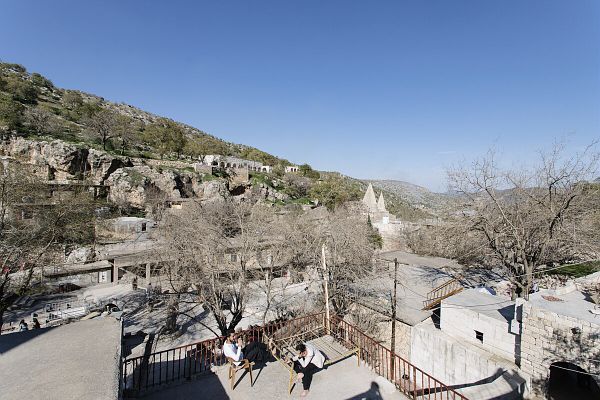
Lalish
Gabriel Gauffre / Le Pictorium
LePictorium_0282188.jpg
View of the Lalish temples.
Lalish, located in the heart of Iraqi Kurdistan, is the most sacred site to the Yazidi. They must make the pilgrimage there at least once in their life, for six days, in order to pay their respects to Sheikh Adi ibn Musafir’s tomb, the founder of the religion. They are about 700 000 in Iraq. Founded in the 12th century, the religion mixes elements of Islam with local pre-Islamic beliefs, making them a major target during the expansion of the Islamic state in Iraq.
Lalish, located in the heart of Iraqi Kurdistan, is the most sacred site to the Yazidi. They must make the pilgrimage there at least once in their life, for six days, in order to pay their respects to Sheikh Adi ibn Musafir’s tomb, the founder of the religion. They are about 700 000 in Iraq. Founded in the 12th century, the religion mixes elements of Islam with local pre-Islamic beliefs, making them a major target during the expansion of the Islamic state in Iraq.
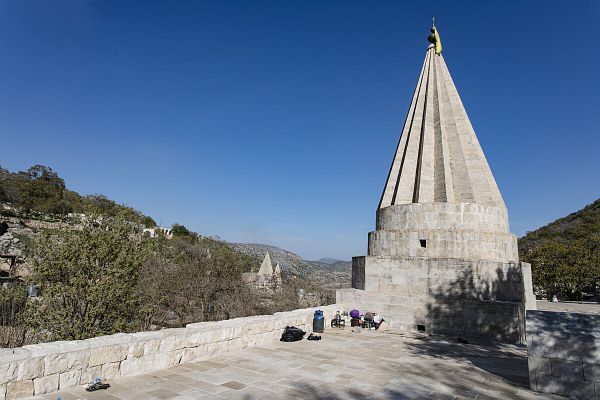
Lalish
Gabriel Gauffre / Le Pictorium
LePictorium_0282189.jpg
View of the Lalish temples.
Lalish, located in the heart of Iraqi Kurdistan, is the most sacred site to the Yazidi. They must make the pilgrimage there at least once in their life, for six days, in order to pay their respects to Sheikh Adi ibn Musafir’s tomb, the founder of the religion. They are about 700 000 in Iraq. Founded in the 12th century, the religion mixes elements of Islam with local pre-Islamic beliefs, making them a major target during the expansion of the Islamic state in Iraq.
Lalish, located in the heart of Iraqi Kurdistan, is the most sacred site to the Yazidi. They must make the pilgrimage there at least once in their life, for six days, in order to pay their respects to Sheikh Adi ibn Musafir’s tomb, the founder of the religion. They are about 700 000 in Iraq. Founded in the 12th century, the religion mixes elements of Islam with local pre-Islamic beliefs, making them a major target during the expansion of the Islamic state in Iraq.
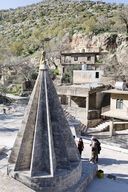
Lalish
Gabriel Gauffre / Le Pictorium
LePictorium_0282190.jpg
View of the Lalish temples.
Lalish, located in the heart of Iraqi Kurdistan, is the most sacred site to the Yazidi. They must make the pilgrimage there at least once in their life, for six days, in order to pay their respects to Sheikh Adi ibn Musafir’s tomb, the founder of the religion. They are about 700 000 in Iraq. Founded in the 12th century, the religion mixes elements of Islam with local pre-Islamic beliefs, making them a major target during the expansion of the Islamic state in Iraq.
Lalish, located in the heart of Iraqi Kurdistan, is the most sacred site to the Yazidi. They must make the pilgrimage there at least once in their life, for six days, in order to pay their respects to Sheikh Adi ibn Musafir’s tomb, the founder of the religion. They are about 700 000 in Iraq. Founded in the 12th century, the religion mixes elements of Islam with local pre-Islamic beliefs, making them a major target during the expansion of the Islamic state in Iraq.
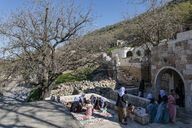
Lalish
Gabriel Gauffre / Le Pictorium
LePictorium_0282191.jpg
The faithful rest during a pilgrimage.
Lalish, located in the heart of Iraqi Kurdistan, is the most sacred site to the Yazidi. They must make the pilgrimage there at least once in their life, for six days, in order to pay their respects to Sheikh Adi ibn Musafir’s tomb, the founder of the religion. They are about 700 000 in Iraq. Founded in the 12th century, the religion mixes elements of Islam with local pre-Islamic beliefs, making them a major target during the expansion of the Islamic state in Iraq.
Lalish, located in the heart of Iraqi Kurdistan, is the most sacred site to the Yazidi. They must make the pilgrimage there at least once in their life, for six days, in order to pay their respects to Sheikh Adi ibn Musafir’s tomb, the founder of the religion. They are about 700 000 in Iraq. Founded in the 12th century, the religion mixes elements of Islam with local pre-Islamic beliefs, making them a major target during the expansion of the Islamic state in Iraq.
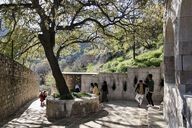
Lalish
Gabriel Gauffre / Le Pictorium
LePictorium_0282192.jpg
Pilgrims in Lalish.
Lalish, located in the heart of Iraqi Kurdistan, is the most sacred site to the Yazidi. They must make the pilgrimage there at least once in their life, for six days, in order to pay their respects to Sheikh Adi ibn Musafir’s tomb, the founder of the religion. They are about 700 000 in Iraq. Founded in the 12th century, the religion mixes elements of Islam with local pre-Islamic beliefs, making them a major target during the expansion of the Islamic state in Iraq.
Lalish, located in the heart of Iraqi Kurdistan, is the most sacred site to the Yazidi. They must make the pilgrimage there at least once in their life, for six days, in order to pay their respects to Sheikh Adi ibn Musafir’s tomb, the founder of the religion. They are about 700 000 in Iraq. Founded in the 12th century, the religion mixes elements of Islam with local pre-Islamic beliefs, making them a major target during the expansion of the Islamic state in Iraq.
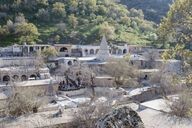
Lalish
Gabriel Gauffre / Le Pictorium
LePictorium_0282193.jpg
View of the Lalish temples.
Lalish, located in the heart of Iraqi Kurdistan, is the most sacred site to the Yazidi. They must make the pilgrimage there at least once in their life, for six days, in order to pay their respects to Sheikh Adi ibn Musafir’s tomb, the founder of the religion. They are about 700 000 in Iraq. Founded in the 12th century, the religion mixes elements of Islam with local pre-Islamic beliefs, making them a major target during the expansion of the Islamic state in Iraq.
Lalish, located in the heart of Iraqi Kurdistan, is the most sacred site to the Yazidi. They must make the pilgrimage there at least once in their life, for six days, in order to pay their respects to Sheikh Adi ibn Musafir’s tomb, the founder of the religion. They are about 700 000 in Iraq. Founded in the 12th century, the religion mixes elements of Islam with local pre-Islamic beliefs, making them a major target during the expansion of the Islamic state in Iraq.
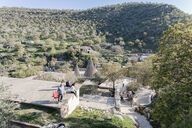
Lalish
Gabriel Gauffre / Le Pictorium
LePictorium_0282194.jpg
View of the Lalish temples.
Lalish, located in the heart of Iraqi Kurdistan, is the most sacred site to the Yazidi. They must make the pilgrimage there at least once in their life, for six days, in order to pay their respects to Sheikh Adi ibn Musafir’s tomb, the founder of the religion. They are about 700 000 in Iraq. Founded in the 12th century, the religion mixes elements of Islam with local pre-Islamic beliefs, making them a major target during the expansion of the Islamic state in Iraq.
Lalish, located in the heart of Iraqi Kurdistan, is the most sacred site to the Yazidi. They must make the pilgrimage there at least once in their life, for six days, in order to pay their respects to Sheikh Adi ibn Musafir’s tomb, the founder of the religion. They are about 700 000 in Iraq. Founded in the 12th century, the religion mixes elements of Islam with local pre-Islamic beliefs, making them a major target during the expansion of the Islamic state in Iraq.
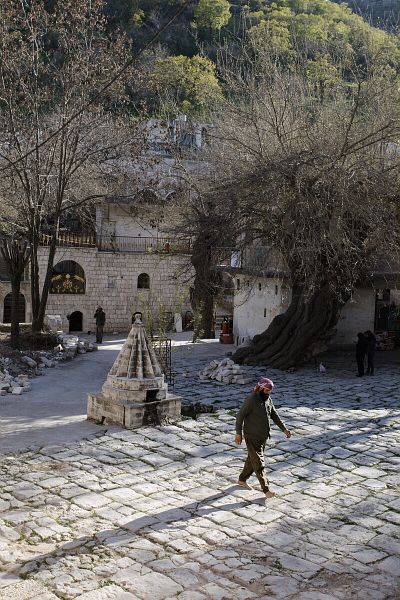
Lalish
Gabriel Gauffre / Le Pictorium
LePictorium_0282195.jpg
View of the Lalish temples.
Lalish, located in the heart of Iraqi Kurdistan, is the most sacred site to the Yazidi. They must make the pilgrimage there at least once in their life, for six days, in order to pay their respects to Sheikh Adi ibn Musafir’s tomb, the founder of the religion. They are about 700 000 in Iraq. Founded in the 12th century, the religion mixes elements of Islam with local pre-Islamic beliefs, making them a major target during the expansion of the Islamic state in Iraq.
Lalish, located in the heart of Iraqi Kurdistan, is the most sacred site to the Yazidi. They must make the pilgrimage there at least once in their life, for six days, in order to pay their respects to Sheikh Adi ibn Musafir’s tomb, the founder of the religion. They are about 700 000 in Iraq. Founded in the 12th century, the religion mixes elements of Islam with local pre-Islamic beliefs, making them a major target during the expansion of the Islamic state in Iraq.
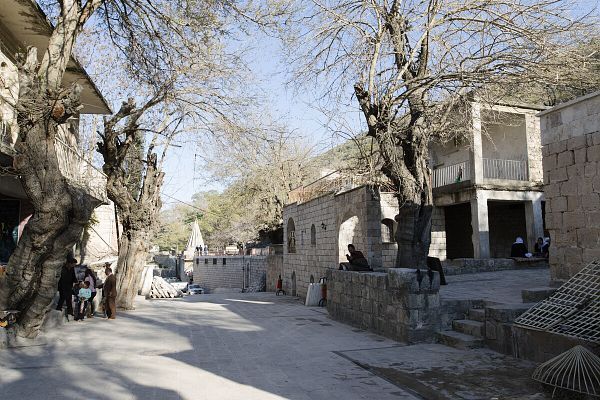
Lalish
Gabriel Gauffre / Le Pictorium
LePictorium_0282196.jpg
The main street of the Lalish religious complex.
Lalish, located in the heart of Iraqi Kurdistan, is the most sacred site to the Yazidi. They must make the pilgrimage there at least once in their life, for six days, in order to pay their respects to Sheikh Adi ibn Musafir’s tomb, the founder of the religion. They are about 700 000 in Iraq. Founded in the 12th century, the religion mixes elements of Islam with local pre-Islamic beliefs, making them a major target during the expansion of the Islamic state in Iraq.
Lalish, located in the heart of Iraqi Kurdistan, is the most sacred site to the Yazidi. They must make the pilgrimage there at least once in their life, for six days, in order to pay their respects to Sheikh Adi ibn Musafir’s tomb, the founder of the religion. They are about 700 000 in Iraq. Founded in the 12th century, the religion mixes elements of Islam with local pre-Islamic beliefs, making them a major target during the expansion of the Islamic state in Iraq.
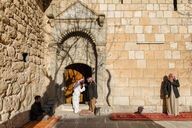
Lalish
Gabriel Gauffre / Le Pictorium
LePictorium_0282197.jpg
Pilgrims in Lalish.
Lalish, located in the heart of Iraqi Kurdistan, is the most sacred site to the Yazidi. They must make the pilgrimage there at least once in their life, for six days, in order to pay their respects to Sheikh Adi ibn Musafir’s tomb, the founder of the religion. They are about 700 000 in Iraq. Founded in the 12th century, the religion mixes elements of Islam with local pre-Islamic beliefs, making them a major target during the expansion of the Islamic state in Iraq.
Lalish, located in the heart of Iraqi Kurdistan, is the most sacred site to the Yazidi. They must make the pilgrimage there at least once in their life, for six days, in order to pay their respects to Sheikh Adi ibn Musafir’s tomb, the founder of the religion. They are about 700 000 in Iraq. Founded in the 12th century, the religion mixes elements of Islam with local pre-Islamic beliefs, making them a major target during the expansion of the Islamic state in Iraq.
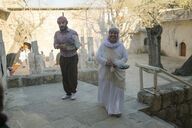
Lalish
Gabriel Gauffre / Le Pictorium
LePictorium_0282198.jpg
A priestess during a ceremony in Lalish.
Lalish, located in the heart of Iraqi Kurdistan, is the most sacred site to the Yazidi. They must make the pilgrimage there at least once in their life, for six days, in order to pay their respects to Sheikh Adi ibn Musafir’s tomb, the founder of the religion. They are about 700 000 in Iraq. Founded in the 12th century, the religion mixes elements of Islam with local pre-Islamic beliefs, making them a major target during the expansion of the Islamic state in Iraq.
Lalish, located in the heart of Iraqi Kurdistan, is the most sacred site to the Yazidi. They must make the pilgrimage there at least once in their life, for six days, in order to pay their respects to Sheikh Adi ibn Musafir’s tomb, the founder of the religion. They are about 700 000 in Iraq. Founded in the 12th century, the religion mixes elements of Islam with local pre-Islamic beliefs, making them a major target during the expansion of the Islamic state in Iraq.
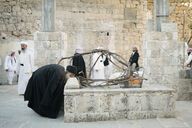
Lalish
Gabriel Gauffre / Le Pictorium
LePictorium_0282199.jpg
Lalish, located in the heart of Iraqi Kurdistan, is the most sacred site to the Yazidi. They must make the pilgrimage there at least once in their life, for six days, in order to pay their respects to Sheikh Adi ibn Musafir’s tomb, the founder of the religion. They are about 700 000 in Iraq. Founded in the 12th century, the religion mixes elements of Islam with local pre-Islamic beliefs, making them a major target during the expansion of the Islamic state in Iraq.
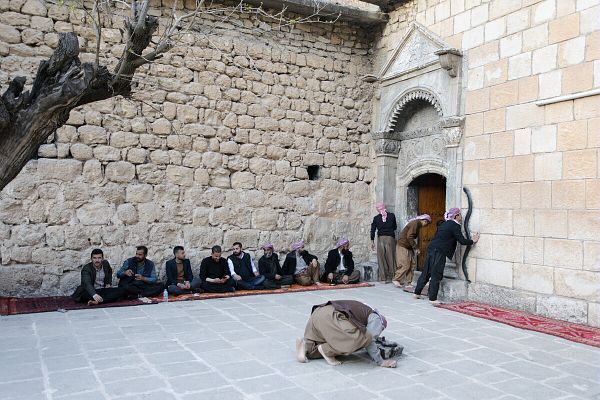
Lalish
Gabriel Gauffre / Le Pictorium
LePictorium_0282200.jpg
A pilgrim kisses a sacred stone in Lalish.
Lalish, located in the heart of Iraqi Kurdistan, is the most sacred site to the Yazidi. They must make the pilgrimage there at least once in their life, for six days, in order to pay their respects to Sheikh Adi ibn Musafir’s tomb, the founder of the religion. They are about 700 000 in Iraq. Founded in the 12th century, the religion mixes elements of Islam with local pre-Islamic beliefs, making them a major target during the expansion of the Islamic state in Iraq.
Lalish, located in the heart of Iraqi Kurdistan, is the most sacred site to the Yazidi. They must make the pilgrimage there at least once in their life, for six days, in order to pay their respects to Sheikh Adi ibn Musafir’s tomb, the founder of the religion. They are about 700 000 in Iraq. Founded in the 12th century, the religion mixes elements of Islam with local pre-Islamic beliefs, making them a major target during the expansion of the Islamic state in Iraq.
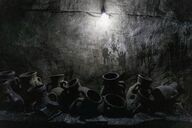
Lalish
Gabriel Gauffre / Le Pictorium
LePictorium_0282201.jpg
The Hesen Dana room, containing the jars filled with the oil used to light the temple's 365 lamps.
Lalish, located in the heart of Iraqi Kurdistan, is the most sacred site to the Yazidi. They must make the pilgrimage there at least once in their life, for six days, in order to pay their respects to Sheikh Adi ibn Musafir’s tomb, the founder of the religion. They are about 700 000 in Iraq. Founded in the 12th century, the religion mixes elements of Islam with local pre-Islamic beliefs, making them a major target during the expansion of the Islamic state in Iraq.
Lalish, located in the heart of Iraqi Kurdistan, is the most sacred site to the Yazidi. They must make the pilgrimage there at least once in their life, for six days, in order to pay their respects to Sheikh Adi ibn Musafir’s tomb, the founder of the religion. They are about 700 000 in Iraq. Founded in the 12th century, the religion mixes elements of Islam with local pre-Islamic beliefs, making them a major target during the expansion of the Islamic state in Iraq.
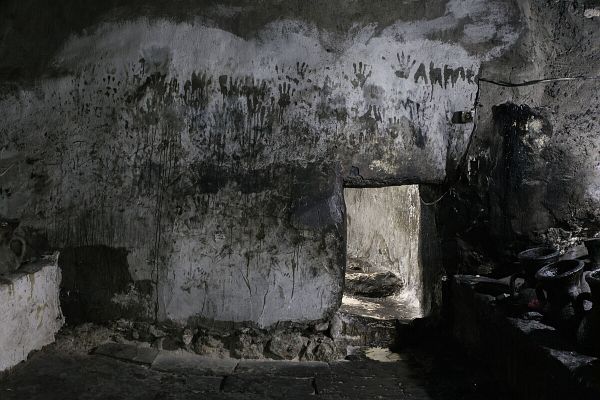
Lalish
Gabriel Gauffre / Le Pictorium
LePictorium_0282202.jpg
The Hesen Dana room, containing the jars filled with the oil used to light the temple's 365 lamps.
Lalish, located in the heart of Iraqi Kurdistan, is the most sacred site to the Yazidi. They must make the pilgrimage there at least once in their life, for six days, in order to pay their respects to Sheikh Adi ibn Musafir’s tomb, the founder of the religion. They are about 700 000 in Iraq. Founded in the 12th century, the religion mixes elements of Islam with local pre-Islamic beliefs, making them a major target during the expansion of the Islamic state in Iraq.
Lalish, located in the heart of Iraqi Kurdistan, is the most sacred site to the Yazidi. They must make the pilgrimage there at least once in their life, for six days, in order to pay their respects to Sheikh Adi ibn Musafir’s tomb, the founder of the religion. They are about 700 000 in Iraq. Founded in the 12th century, the religion mixes elements of Islam with local pre-Islamic beliefs, making them a major target during the expansion of the Islamic state in Iraq.
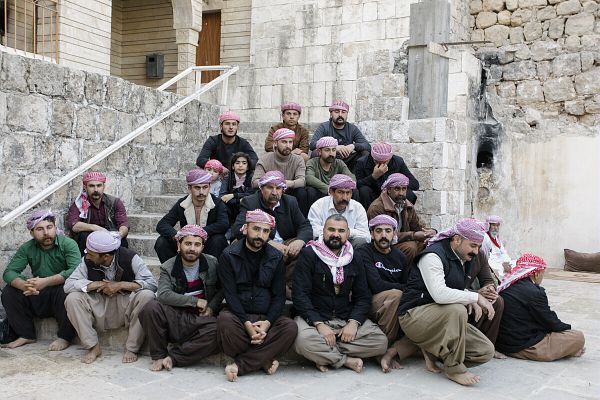
Lalish
Gabriel Gauffre / Le Pictorium
LePictorium_0282203.jpg
A group of Yezidi men in the temple's central courtyard.
Lalish, located in the heart of Iraqi Kurdistan, is the most sacred site to the Yazidi. They must make the pilgrimage there at least once in their life, for six days, in order to pay their respects to Sheikh Adi ibn Musafir’s tomb, the founder of the religion. They are about 700 000 in Iraq. Founded in the 12th century, the religion mixes elements of Islam with local pre-Islamic beliefs, making them a major target during the expansion of the Islamic state in Iraq.
Lalish, located in the heart of Iraqi Kurdistan, is the most sacred site to the Yazidi. They must make the pilgrimage there at least once in their life, for six days, in order to pay their respects to Sheikh Adi ibn Musafir’s tomb, the founder of the religion. They are about 700 000 in Iraq. Founded in the 12th century, the religion mixes elements of Islam with local pre-Islamic beliefs, making them a major target during the expansion of the Islamic state in Iraq.
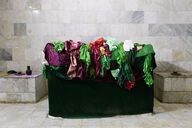
Lalish
Gabriel Gauffre / Le Pictorium
LePictorium_0282204.jpg
The tomb of Sheikh Adi ibn Musafir.
Lalish, located in the heart of Iraqi Kurdistan, is the most sacred site to the Yazidi. They must make the pilgrimage there at least once in their life, for six days, in order to pay their respects to Sheikh Adi ibn Musafir’s tomb, the founder of the religion. They are about 700 000 in Iraq. Founded in the 12th century, the religion mixes elements of Islam with local pre-Islamic beliefs, making them a major target during the expansion of the Islamic state in Iraq.
Lalish, located in the heart of Iraqi Kurdistan, is the most sacred site to the Yazidi. They must make the pilgrimage there at least once in their life, for six days, in order to pay their respects to Sheikh Adi ibn Musafir’s tomb, the founder of the religion. They are about 700 000 in Iraq. Founded in the 12th century, the religion mixes elements of Islam with local pre-Islamic beliefs, making them a major target during the expansion of the Islamic state in Iraq.

Israel
Michael Bunel / Le Pictorium
LePictorium_0233639.jpg
Christian religious souvenir in a store near the Church of the Holy Sepulchre. The Holy Sepulchre is according to Christian tradition, the tomb of Christ, that is to say the sepulchre where the body of Jesus of Nazareth would have been deposited on the evening of his death on the Cross. May 09, 2018. Jerusalem. Israel
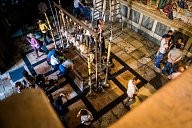
Israel
Michael Bunel / Le Pictorium
LePictorium_0233640.jpg
Pilgrims prostrate themselves on the Stone of the Anointing at the entrance to the Holy Sepulchre. The Holy Sepulchre is according to Christian tradition, the tomb of Christ, that is to say the sepulchre where the body of Jesus of Nazareth would have been deposited on the evening of his death on the Cross. May 09, 2018. Jerusalem. Israel
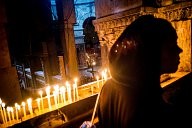
Israel
Michael Bunel / Le Pictorium
LePictorium_0233641.jpg
A woman in the Church of the Holy Sepulchre, walks past a row of candles. In the background a cross can be seen. The Holy Sepulchre is according to Christian tradition, the tomb of Christ, that is to say the sepulchre where the body of Jesus of Nazareth would have been deposited on the evening of his death on the Cross. May 09, 2018. Jerusalem. Israel
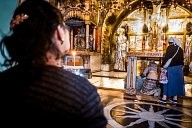
Israel
Michael Bunel / Le Pictorium
LePictorium_0233642.jpg
Pilgrims prostrate themselves in the Calvary Chapel, which corresponds to the twelfth station of the Way of Jesus. Holy Sepulcher. The Holy Sepulchre is, according to Christian tradition, the tomb of Christ, i.e. the sepulchre where the body of Jesus of Nazareth was deposited on the evening of his death on the Cross. May 09, 2018. Jerusalem. Israel

Israel
Michael Bunel / Le Pictorium
LePictorium_0233643.jpg
Various inscriptions carved in the stone of the steps of the Church of the Holy Sepulchre. The Holy Sepulchre is according to Christian tradition, the tomb of Christ, that is to say, the sepulchre where the body of Jesus of Nazareth would have been deposited on the evening of his death on the Cross. May 09, 2018. Jerusalem. Israel
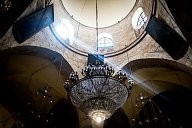
Israel
Michael Bunel / Le Pictorium
LePictorium_0233644.jpg
A chandelier illuminated by a ray of light hangs from the ceiling of one of the rooms of the Holy Sepulchre. The Holy Sepulcher is, according to Christian tradition, the tomb of Christ, that is, the sepulcher where the body of Jesus of Nazareth is said to have been laid on the evening of his death on the Cross. May 9, 2018. Jerusalem. Israel
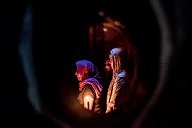
Israel
Michael Bunel / Le Pictorium
LePictorium_0233645.jpg
Pilgrims gather in front of the tomb of Jesus, the Holy Sepulcher (14th station). The Holy Sepulchre is according to Christian tradition, the tomb of Christ, that is to say, the sepulchre where the body of Jesus of Nazareth would have been deposited on the evening of his death on the Cross. May 09, 2018. Jerusalem. Israel
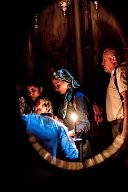
Israel
Michael Bunel / Le Pictorium
LePictorium_0233646.jpg
Pilgrims gather in front of the tomb of Jesus, the Holy Sepulcher (14th station). The Holy Sepulchre is according to Christian tradition, the tomb of Christ, that is to say, the sepulchre where the body of Jesus of Nazareth would have been deposited on the evening of his death on the Cross. May 09, 2018. Jerusalem. Israel
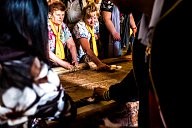
Israel
Michael Bunel / Le Pictorium
LePictorium_0233647.jpg
Pilgrims prostrate themselves on the Stone of the Anointing at the entrance to the Holy Sepulchre. The Holy Sepulchre is according to Christian tradition, the tomb of Christ, that is to say the sepulchre where the body of Jesus of Nazareth would have been deposited on the evening of his death on the Cross. May 09, 2018. Jerusalem. Israel
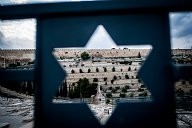
Israel
Michael Bunel / Le Pictorium
LePictorium_0233659.jpg
View of al-Aqsa Mosque (Al-aksa) and the Dome of the Rock from the Mount of Olives. May 9, 2018. Jerusalem. Israel. Palestine.

Israel
Michael Bunel / Le Pictorium
LePictorium_0233661.jpg
View of al-Aqsa Mosque (Al-aksa) and the Dome of the Rock from the Mount of Olives. May 9, 2018. Jerusalem. Israel. Palestine.
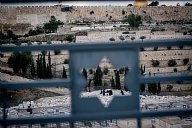
Israel
Michael Bunel / Le Pictorium
LePictorium_0233662.jpg
View of al-Aqsa Mosque (Al-aksa) and the Dome of the Rock from the Mount of Olives. May 9, 2018. Jerusalem. Israel. Palestine.
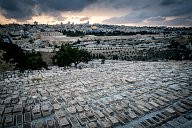
Israel
Michael Bunel / Le Pictorium
LePictorium_0233663.jpg
View of al-Aqsa Mosque (Al-aksa) and the Dome of the Rock from the Mount of Olives. May 9, 2018. Jerusalem. Israel. Palestine.
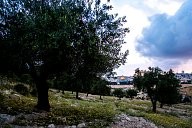
Israel
Michael Bunel / Le Pictorium
LePictorium_0233665.jpg
View of al-Aqsa Mosque (Al-aksa) and the Dome of the Rock from the Mount of Olives. May 9, 2018. Jerusalem. Israel. Palestine.

Original Christian holy place of the cave of the Seven Sleepers
Manoël Pénicaud / Le Pictorium
LePictorium_0169801.jpg
Known in Islam as the People of the Cave
(Ahl al-Kahf in Arabic), the Seven Sleepers are said to have miraculously slept for several centuries in a cave in order to escape from the persecutions of the Roman Empire. Their awakening is a metaphor for the resurrection
of the body, in both Christianity and in Islam
(Qur’anic sura ‘The Cave’). The narratives
of the Seven Sleepers were widely disseminated. Numerous caves in the Mediterranean region are considered to be sacred places where this miracle occurred. This legend has sometimes given rise to joint veneration by Christians and Muslims.
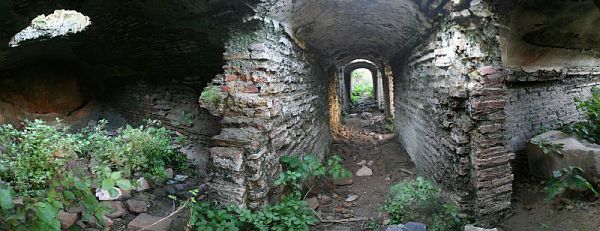
Crypt of the Seven Sleepers in Ephesus
Manoël Pénicaud / Le Pictorium
LePictorium_0169802.jpg
Known in Islam as the People of the Cave
(Ahl al-Kahf in Arabic), the Seven Sleepers are said to have miraculously slept for several centuries in a cave in order to escape from the persecutions of the Roman Empire. Their awakening is a metaphor for the resurrection
of the body, in both Christianity and in Islam
(Qur’anic sura ‘The Cave’). The narratives
of the Seven Sleepers were widely disseminated. Numerous caves in the Mediterranean region are considered to be sacred places where this miracle occurred. This legend has sometimes given rise to joint veneration by Christians and Muslims.
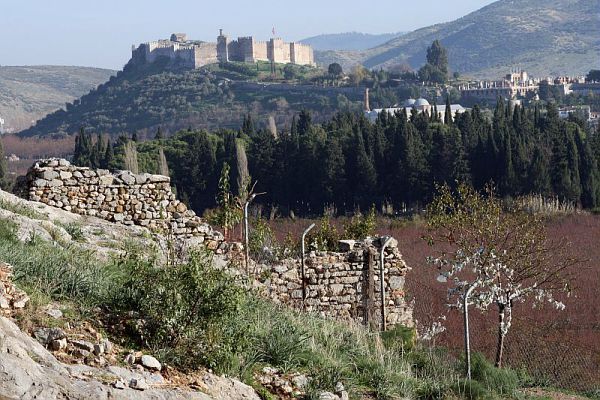
Citadel of Saint John, from the 7 Dormants site, with a wishing tree
Manoël Pénicaud / Le Pictorium
LePictorium_0169803.jpg
Known in Islam as the People of the Cave
(Ahl al-Kahf in Arabic), the Seven Sleepers are said to have miraculously slept for several centuries in a cave in order to escape from the persecutions of the Roman Empire. Their awakening is a metaphor for the resurrection
of the body, in both Christianity and in Islam
(Qur’anic sura ‘The Cave’). The narratives
of the Seven Sleepers were widely disseminated. Numerous caves in the Mediterranean region are considered to be sacred places where this miracle occurred. This legend has sometimes given rise to joint veneration by Christians and Muslims.

Sanctuary of the 7 Sleepers in Tarsus
Manoël Pénicaud / Le Pictorium
LePictorium_0169804.jpg
Known in Islam as the People of the Cave
(Ahl al-Kahf in Arabic), the Seven Sleepers are said to have miraculously slept for several centuries in a cave in order to escape from the persecutions of the Roman Empire. Their awakening is a metaphor for the resurrection
of the body, in both Christianity and in Islam
(Qur’anic sura ‘The Cave’). The narratives
of the Seven Sleepers were widely disseminated. Numerous caves in the Mediterranean region are considered to be sacred places where this miracle occurred. This legend has sometimes given rise to joint veneration by Christians and Muslims.
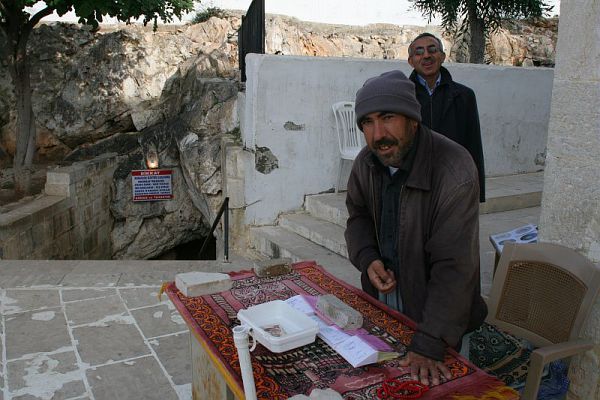
The guardian and the imam of the sanctuary. The second recognizes the Christian past in the history of the Seven Sleepers.
Manoël Pénicaud / Le Pictorium
LePictorium_0169805.jpg
Known in Islam as the People of the Cave
(Ahl al-Kahf in Arabic), the Seven Sleepers are said to have miraculously slept for several centuries in a cave in order to escape from the persecutions of the Roman Empire. Their awakening is a metaphor for the resurrection
of the body, in both Christianity and in Islam
(Qur’anic sura ‘The Cave’). The narratives
of the Seven Sleepers were widely disseminated. Numerous caves in the Mediterranean region are considered to be sacred places where this miracle occurred. This legend has sometimes given rise to joint veneration by Christians and Muslims.

Pilgrims in the Cave of the 7 Dormants
Manoël Pénicaud / Le Pictorium
LePictorium_0169806.jpg
The site is very popular and frequented. For the pilgrims, this is the true place of the miracle.
Known in Islam as the People of the Cave (Ahl al-Kahf in Arabic), the Seven Sleepers are said to have miraculously slept for several centuries in a cave in order to escape from the persecutions of the Roman Empire. Their awakening is a metaphor for the resurrection of the body, in both Christianity and in Islam (Qur’anic sura ‘The Cave’). The narratives of the Seven Sleepers were widely disseminated. Numerous caves in the Mediterranean region are considered to be sacred places where this miracle occurred. This legend has sometimes given rise to joint veneration by Christians and Muslims.
Known in Islam as the People of the Cave (Ahl al-Kahf in Arabic), the Seven Sleepers are said to have miraculously slept for several centuries in a cave in order to escape from the persecutions of the Roman Empire. Their awakening is a metaphor for the resurrection of the body, in both Christianity and in Islam (Qur’anic sura ‘The Cave’). The narratives of the Seven Sleepers were widely disseminated. Numerous caves in the Mediterranean region are considered to be sacred places where this miracle occurred. This legend has sometimes given rise to joint veneration by Christians and Muslims.

The pilgrims aim at receiving drops of water that pear from the ceiling of the cave
Manoël Pénicaud / Le Pictorium
LePictorium_0169807.jpg
Known in Islam as the People of the Cave
(Ahl al-Kahf in Arabic), the Seven Sleepers are said to have miraculously slept for several centuries in a cave in order to escape from the persecutions of the Roman Empire. Their awakening is a metaphor for the resurrection
of the body, in both Christianity and in Islam
(Qur’anic sura ‘The Cave’). The narratives
of the Seven Sleepers were widely disseminated. Numerous caves in the Mediterranean region are considered to be sacred places where this miracle occurred. This legend has sometimes given rise to joint veneration by Christians and Muslims.

The pilgrims aim at receiving drops of water that pear from the ceiling of the cave
Manoël Pénicaud / Le Pictorium
LePictorium_0169808.jpg
Known in Islam as the People of the Cave
(Ahl al-Kahf in Arabic), the Seven Sleepers are said to have miraculously slept for several centuries in a cave in order to escape from the persecutions of the Roman Empire. Their awakening is a metaphor for the resurrection
of the body, in both Christianity and in Islam
(Qur’anic sura ‘The Cave’). The narratives
of the Seven Sleepers were widely disseminated. Numerous caves in the Mediterranean region are considered to be sacred places where this miracle occurred. This legend has sometimes given rise to joint veneration by Christians and Muslims.

Door of the minaret of the sanctuary. Eshab i-Kehf means the "Companions of the Cave" to designate the Seven Sleepers
Manoël Pénicaud / Le Pictorium
LePictorium_0169809.jpg
Known in Islam as the People of the Cave
(Ahl al-Kahf in Arabic), the Seven Sleepers are said to have miraculously slept for several centuries in a cave in order to escape from the persecutions of the Roman Empire. Their awakening is a metaphor for the resurrection
of the body, in both Christianity and in Islam
(Qur’anic sura ‘The Cave’). The narratives
of the Seven Sleepers were widely disseminated. Numerous caves in the Mediterranean region are considered to be sacred places where this miracle occurred. This legend has sometimes given rise to joint veneration by Christians and Muslims.

Bus (Dolmush) to go the sanctuary
Manoël Pénicaud / Le Pictorium
LePictorium_0169810.jpg
Known in Islam as the People of the Cave
(Ahl al-Kahf in Arabic), the Seven Sleepers are said to have miraculously slept for several centuries in a cave in order to escape from the persecutions of the Roman Empire. Their awakening is a metaphor for the resurrection
of the body, in both Christianity and in Islam
(Qur’anic sura ‘The Cave’). The narratives
of the Seven Sleepers were widely disseminated. Numerous caves in the Mediterranean region are considered to be sacred places where this miracle occurred. This legend has sometimes given rise to joint veneration by Christians and Muslims.
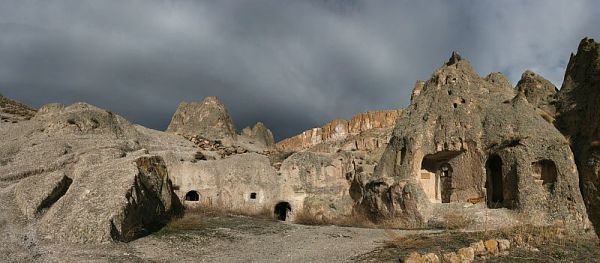
Rock church of Santa Barbara (Tahtali) with a fresco representing three of the Seven Sleepers
Manoël Pénicaud / Le Pictorium
LePictorium_0169811.jpg
Known in Islam as the People of the Cave
(Ahl al-Kahf in Arabic), the Seven Sleepers are said to have miraculously slept for several centuries in a cave in order to escape from the persecutions of the Roman Empire. Their awakening is a metaphor for the resurrection
of the body, in both Christianity and in Islam
(Qur’anic sura ‘The Cave’). The narratives
of the Seven Sleepers were widely disseminated. Numerous caves in the Mediterranean region are considered to be sacred places where this miracle occurred. This legend has sometimes given rise to joint veneration by Christians and Muslims.
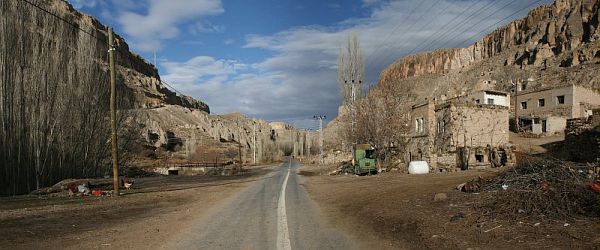
A Cappadocian Road, Soganli Valley
Manoël Pénicaud / Le Pictorium
LePictorium_0169812.jpg
Known in Islam as the People of the Cave
(Ahl al-Kahf in Arabic), the Seven Sleepers are said to have miraculously slept for several centuries in a cave in order to escape from the persecutions of the Roman Empire. Their awakening is a metaphor for the resurrection
of the body, in both Christianity and in Islam
(Qur’anic sura ‘The Cave’). The narratives
of the Seven Sleepers were widely disseminated. Numerous caves in the Mediterranean region are considered to be sacred places where this miracle occurred. This legend has sometimes given rise to joint veneration by Christians and Muslims.

Soganli Valley and the Church of Santa Barbara (Tahtali)
Manoël Pénicaud / Le Pictorium
LePictorium_0169813.jpg
Known in Islam as the People of the Cave
(Ahl al-Kahf in Arabic), the Seven Sleepers are said to have miraculously slept for several centuries in a cave in order to escape from the persecutions of the Roman Empire. Their awakening is a metaphor for the resurrection
of the body, in both Christianity and in Islam
(Qur’anic sura ‘The Cave’). The narratives
of the Seven Sleepers were widely disseminated. Numerous caves in the Mediterranean region are considered to be sacred places where this miracle occurred. This legend has sometimes given rise to joint veneration by Christians and Muslims.

Church of St. Barbara with a fresco depicting three of the Seven Sleepers and the Nativity scene
Manoël Pénicaud / Le Pictorium
LePictorium_0169814.jpg
Known in Islam as the People of the Cave
(Ahl al-Kahf in Arabic), the Seven Sleepers are said to have miraculously slept for several centuries in a cave in order to escape from the persecutions of the Roman Empire. Their awakening is a metaphor for the resurrection
of the body, in both Christianity and in Islam
(Qur’anic sura ‘The Cave’). The narratives
of the Seven Sleepers were widely disseminated. Numerous caves in the Mediterranean region are considered to be sacred places where this miracle occurred. This legend has sometimes given rise to joint veneration by Christians and Muslims.
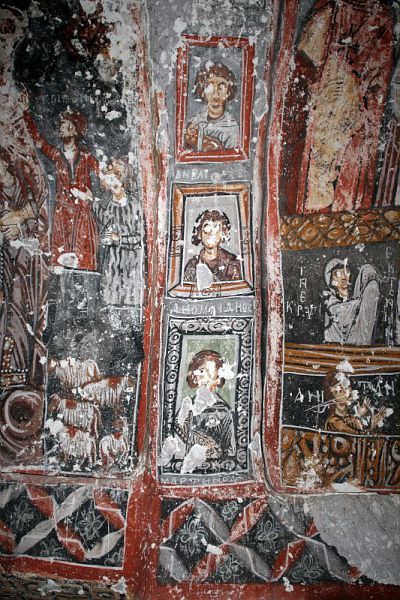
Church of St. Barbara with a fresco depicting three of the Seven Sleepers
Manoël Pénicaud / Le Pictorium
LePictorium_0169815.jpg
Known in Islam as the People of the Cave
(Ahl al-Kahf in Arabic), the Seven Sleepers are said to have miraculously slept for several centuries in a cave in order to escape from the persecutions of the Roman Empire. Their awakening is a metaphor for the resurrection
of the body, in both Christianity and in Islam
(Qur’anic sura ‘The Cave’). The narratives
of the Seven Sleepers were widely disseminated. Numerous caves in the Mediterranean region are considered to be sacred places where this miracle occurred. This legend has sometimes given rise to joint veneration by Christians and Muslims.
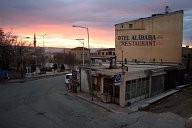
A Cappadocian village
Manoël Pénicaud / Le Pictorium
LePictorium_0169816.jpg
Known in Islam as the People of the Cave
(Ahl al-Kahf in Arabic), the Seven Sleepers are said to have miraculously slept for several centuries in a cave in order to escape from the persecutions of the Roman Empire. Their awakening is a metaphor for the resurrection
of the body, in both Christianity and in Islam
(Qur’anic sura ‘The Cave’). The narratives
of the Seven Sleepers were widely disseminated. Numerous caves in the Mediterranean region are considered to be sacred places where this miracle occurred. This legend has sometimes given rise to joint veneration by Christians and Muslims.
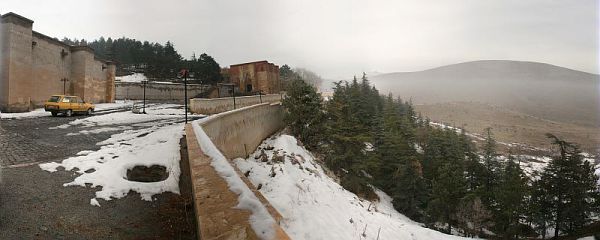
Old caravanserai of the Seven Sleepers in Afsin, on the border of Kurdistan in Turkey
Manoël Pénicaud / Le Pictorium
LePictorium_0169817.jpg
The site formerly cohabited with a church.
Known in Islam as the People of the Cave (Ahl al-Kahf in Arabic), the Seven Sleepers are said to have miraculously slept for several centuries in a cave in order to escape from the persecutions of the Roman Empire. Their awakening is a metaphor for the resurrection of the body, in both Christianity and in Islam (Qur’anic sura ‘The Cave’). The narratives of the Seven Sleepers were widely disseminated. Numerous caves in the Mediterranean region are considered to be sacred places where this miracle occurred. This legend has sometimes given rise to joint veneration by Christians and Muslims.
Known in Islam as the People of the Cave (Ahl al-Kahf in Arabic), the Seven Sleepers are said to have miraculously slept for several centuries in a cave in order to escape from the persecutions of the Roman Empire. Their awakening is a metaphor for the resurrection of the body, in both Christianity and in Islam (Qur’anic sura ‘The Cave’). The narratives of the Seven Sleepers were widely disseminated. Numerous caves in the Mediterranean region are considered to be sacred places where this miracle occurred. This legend has sometimes given rise to joint veneration by Christians and Muslims.

Fountain with the Turkish names of the Seven Sleepers in an old caravanserai on the Silk Road
Manoël Pénicaud / Le Pictorium
LePictorium_0169818.jpg
Known in Islam as the People of the Cave
(Ahl al-Kahf in Arabic), the Seven Sleepers are said to have miraculously slept for several centuries in a cave in order to escape from the persecutions of the Roman Empire. Their awakening is a metaphor for the resurrection
of the body, in both Christianity and in Islam
(Qur’anic sura ‘The Cave’). The narratives
of the Seven Sleepers were widely disseminated. Numerous caves in the Mediterranean region are considered to be sacred places where this miracle occurred. This legend has sometimes given rise to joint veneration by Christians and Muslims.
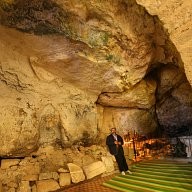
Cave of the Seven Sleepers in Afsin
Manoël Pénicaud / Le Pictorium
LePictorium_0169819.jpg
Known in Islam as the People of the Cave
(Ahl al-Kahf in Arabic), the Seven Sleepers are said to have miraculously slept for several centuries in a cave in order to escape from the persecutions of the Roman Empire. Their awakening is a metaphor for the resurrection
of the body, in both Christianity and in Islam
(Qur’anic sura ‘The Cave’). The narratives
of the Seven Sleepers were widely disseminated. Numerous caves in the Mediterranean region are considered to be sacred places where this miracle occurred. This legend has sometimes given rise to joint veneration by Christians and Muslims.

Wishing Tree in Afsin
Manoël Pénicaud / Le Pictorium
LePictorium_0169821.jpg
Known in Islam as the People of the Cave
(Ahl al-Kahf in Arabic), the Seven Sleepers are said to have miraculously slept for several centuries in a cave in order to escape from the persecutions of the Roman Empire. Their awakening is a metaphor for the resurrection
of the body, in both Christianity and in Islam
(Qur’anic sura ‘The Cave’). The narratives
of the Seven Sleepers were widely disseminated. Numerous caves in the Mediterranean region are considered to be sacred places where this miracle occurred. This legend has sometimes given rise to joint veneration by Christians and Muslims.

the Seven Sleepers
Manoël Pénicaud / Le Pictorium
LePictorium_0169822.jpg
Known in Islam as the People of the Cave
(Ahl al-Kahf in Arabic), the Seven Sleepers are said to have miraculously slept for several centuries in a cave in order to escape from the persecutions of the Roman Empire. Their awakening is a metaphor for the resurrection
of the body, in both Christianity and in Islam
(Qur’anic sura ‘The Cave’). The narratives
of the Seven Sleepers were widely disseminated. Numerous caves in the Mediterranean region are considered to be sacred places where this miracle occurred. This legend has sometimes given rise to joint veneration by Christians and Muslims.
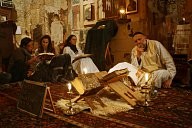
the Seven Sleepers
Manoël Pénicaud / Le Pictorium
LePictorium_0169823.jpg
Known in Islam as the People of the Cave
(Ahl al-Kahf in Arabic), the Seven Sleepers are said to have miraculously slept for several centuries in a cave in order to escape from the persecutions of the Roman Empire. Their awakening is a metaphor for the resurrection
of the body, in both Christianity and in Islam
(Qur’anic sura ‘The Cave’). The narratives
of the Seven Sleepers were widely disseminated. Numerous caves in the Mediterranean region are considered to be sacred places where this miracle occurred. This legend has sometimes given rise to joint veneration by Christians and Muslims.

the Seven Sleepers
Manoël Pénicaud / Le Pictorium
LePictorium_0169824.jpg
Known in Islam as the People of the Cave
(Ahl al-Kahf in Arabic), the Seven Sleepers are said to have miraculously slept for several centuries in a cave in order to escape from the persecutions of the Roman Empire. Their awakening is a metaphor for the resurrection
of the body, in both Christianity and in Islam
(Qur’anic sura ‘The Cave’). The narratives
of the Seven Sleepers were widely disseminated. Numerous caves in the Mediterranean region are considered to be sacred places where this miracle occurred. This legend has sometimes given rise to joint veneration by Christians and Muslims.

the Seven Sleepers
Manoël Pénicaud / Le Pictorium
LePictorium_0169825.jpg
Known in Islam as the People of the Cave
(Ahl al-Kahf in Arabic), the Seven Sleepers are said to have miraculously slept for several centuries in a cave in order to escape from the persecutions of the Roman Empire. Their awakening is a metaphor for the resurrection
of the body, in both Christianity and in Islam
(Qur’anic sura ‘The Cave’). The narratives
of the Seven Sleepers were widely disseminated. Numerous caves in the Mediterranean region are considered to be sacred places where this miracle occurred. This legend has sometimes given rise to joint veneration by Christians and Muslims.
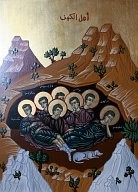
the Seven Sleepers
Manoël Pénicaud / Le Pictorium
LePictorium_0169826.jpg
Known in Islam as the People of the Cave
(Ahl al-Kahf in Arabic), the Seven Sleepers are said to have miraculously slept for several centuries in a cave in order to escape from the persecutions of the Roman Empire. Their awakening is a metaphor for the resurrection
of the body, in both Christianity and in Islam
(Qur’anic sura ‘The Cave’). The narratives
of the Seven Sleepers were widely disseminated. Numerous caves in the Mediterranean region are considered to be sacred places where this miracle occurred. This legend has sometimes given rise to joint veneration by Christians and Muslims.
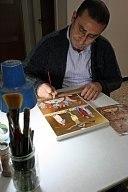
the Seven Sleepers
Manoël Pénicaud / Le Pictorium
LePictorium_0169827.jpg
Known in Islam as the People of the Cave
(Ahl al-Kahf in Arabic), the Seven Sleepers are said to have miraculously slept for several centuries in a cave in order to escape from the persecutions of the Roman Empire. Their awakening is a metaphor for the resurrection
of the body, in both Christianity and in Islam
(Qur’anic sura ‘The Cave’). The narratives
of the Seven Sleepers were widely disseminated. Numerous caves in the Mediterranean region are considered to be sacred places where this miracle occurred. This legend has sometimes given rise to joint veneration by Christians and Muslims.

the Seven Sleepers
Manoël Pénicaud / Le Pictorium
LePictorium_0169828.jpg
Known in Islam as the People of the Cave
(Ahl al-Kahf in Arabic), the Seven Sleepers are said to have miraculously slept for several centuries in a cave in order to escape from the persecutions of the Roman Empire. Their awakening is a metaphor for the resurrection
of the body, in both Christianity and in Islam
(Qur’anic sura ‘The Cave’). The narratives
of the Seven Sleepers were widely disseminated. Numerous caves in the Mediterranean region are considered to be sacred places where this miracle occurred. This legend has sometimes given rise to joint veneration by Christians and Muslims.
Next page
